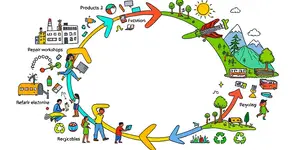Slow fashion is a transformative movement that challenges the conventional approach to clothing consumption. At its heart, it prioritizes quality, sustainability, durability, and ethical practices over the rapid, low-cost production cycles characteristic of fast fashion.
This philosophy encourages consumers and designers alike to embrace thoughtful choices, reducing waste and fostering a more meaningful relationship with our wardrobes.
History and Evolution of Slow Fashion
The term “slow fashion” emerged in the early 2000s as a response to the explosive growth of ultra-fast design-to-store cycles pioneered by brands like Zara and H&M in the 1990s. Where fast fashion churned out new trends weekly, slow fashion called for a more deliberate pace.
Rooted in principles of craftsmanship, fair labor, and environmental stewardship, this approach represented a return to more traditional production methods and buying habits—purchasing fewer, better-made pieces built to stand the test of time.
Slow Fashion vs. Fast Fashion: A Direct Comparison
Understanding the stark contrasts between slow and fast fashion highlights why many industry experts and consumers are making the switch.
The Environmental Consequences of Fast Fashion
The traditional fashion industry ranks as the world’s second-largest consumer of water and is responsible for about 10% of global CO₂ emissions—surpassing the combined emissions of international flights and shipping.
Every year, 85% of all textiles end up in landfills, while washing synthetic garments releases 500,000 tons of microfibers into oceans, equivalent to 50 billion plastic bottles.
By focusing on producing less waste, consuming fewer resources, and emphasizing durability, slow fashion offers a clear path to mitigating these grave environmental impacts.
Core Principles of Slow Fashion
At its foundation, slow fashion rests upon three interwoven pillars:
- Thoughtful clothing production with careful attention to craftsmanship and material selection
- Fair wages and ethical labor practices that respect the dignity of workers
- Environmentally friendly processes that minimize water, energy, and chemical use
These principles drive the creation of high-quality, timeless garments that last longer and carry a lighter footprint on both people and planet.
Benefits of Adopting Slow Fashion
Transitioning to slow fashion yields a wealth of rewards for individuals, communities, and the environment.
- Reducing waste and pollution that harm our planet
- Lower water and energy consumption compared to fast fashion
- Reduced microfiber pollution in water systems annually
- Higher satisfaction with wardrobe choices through craftsmanship
- Personal style development over time instead of chasing trends
- Reduced decision fatigue each morning by simplifying choices
- Better cost-per-wear over time because garments last
- Mindful consumption habits that discourage impulse shopping
- Support for local artisans and fair labor
How to Start Your Slow Fashion Journey
Embracing slow fashion begins with a few intentional steps. Start by auditing your current wardrobe: identify pieces you love, those needing repair, and items you rarely wear.
Next, invest in versatile, mix-and-match pieces made from durable materials like organic cotton, linen, and Tencel. Research brands committed to transparency, ethical production, and environmental stewardship before purchasing.
Consider shopping secondhand or vintage to reduce demand for new textiles and give pre-loved garments a second life. Learn basic mending skills or find a local tailor to extend the life of clothing you already own.
Finally, cultivate mindful care routines by washing garments less frequently, using gentle detergents, and following manufacturer care instructions to preserve fibers and shape.
The Future of Fashion: A Slow Approach
As awareness grows, the momentum behind slow fashion continues to build. Consumers are demanding accountability, while innovative designers pioneer circular models, including take-back programs and biodegradable fabrics.
By choosing a a more responsible and mindful consumption model, each of us can help reshape an industry that touches billions of lives and ecosystems worldwide.
The shift to slow fashion is not merely a trend—it is a necessary evolution toward a healthier planet and a more equitable global community. Every thoughtful purchase brings us one step closer to a sustainable future.
References
- https://www.novatomato.com/blog/benefits-of-slow-fashion/
- https://sanvt.com/blogs/journal/advantages-of-slow-fashion
- https://weavingvibes.com/blogs/blog/the-beauty-of-slowing-down-discovering-the-benefits-of-slow-fashion
- https://www.kolabcollection.com/blogs/news/10-advantages-of-slow-fashion-why-its-time-to-embrace-mindful-style
- https://www.numberanalytics.com/blog/slow-fashion-ultimate-guide
- https://earth.org/fast-fashions-detrimental-effect-on-the-environment/
- https://scholarworks.lib.csusb.edu/cgi/viewcontent.cgi?article=2639&context=etd
- https://italianartisan.com/what-is-slow-fashion/










